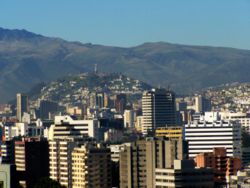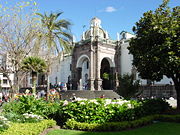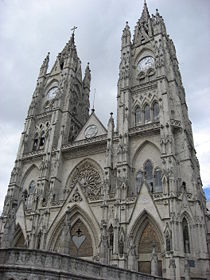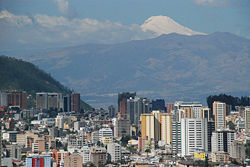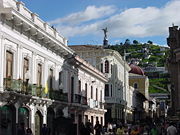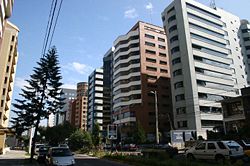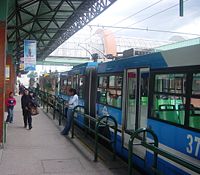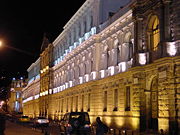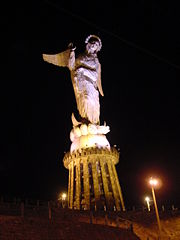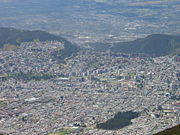Quito
2008/9 Schools Wikipedia Selection. Related subjects: Central and South America; Cities
| Quito | |||
| — City — | |||
| San Francisco de Quito | |||
|
|||
| Nickname(s): Luz de América (Light of America) | |||
| Map of Ecuador showing location of Quito | |||
| Coordinates: | |||
|---|---|---|---|
| Country | Ecuador | ||
| Province | Pichincha | ||
| Canton | Quito | ||
| Founding | 1534-12-06 | ||
| Founder | Sebastián de Benalcázar | ||
| Named for | Quitu | ||
| Urban parishes (electoral urban parishes) | Alfaro, Benalcázar, Chaupicruz, Chillogallo, Cotocollao, El Salvador, González Suárez, Guápulo, La Floresta, La Libertad, La Magdalena, La Vicentina, San Blas, San Marcos, San Roque, San Sebastián, Santa Bárbara, Santa Prisca, Villa Flora | ||
| Government | |||
| - Type | Mayor and council | ||
| - Mayor | Paco Moncayo ( ID) | ||
| - City council |
List of council members
|
||
| Area approx. | |||
| - City | 324 km² (125.1 sq mi) | ||
| - Land | 9,000,000,000 km² (3,474,919,426.9 sq mi) | ||
| - Water | 0 km² (0 sq mi) | ||
| Elevation | 2,850 m (9,350 ft) | ||
| Population (2001-11-24) | |||
| - City | 1,397,698 | ||
| - Metro | 1,842,201 | ||
| Decadal national census by the Instituto Nacional de Estadística y Censos (INEC) | |||
| Time zone | ECT ( UTC-5) | ||
| Postal code | P01 | ||
| Area code(s) | 593 2 | ||
| Municipality's tourism site: http://www.quito.com.ec | |||
| Website: http://www.quito.gov.ec | |||
| City of Quito* | |
|---|---|
| UNESCO World Heritage Site | |
| State Party | |
| Type | Cultural |
| Criteria | ii, iv |
| Reference | 2 |
| Region** | Latin America and the Caribbean |
| Inscription history | |
| Inscription | 1978 (2nd Session) |
| * Name as inscribed on World Heritage List. ** Region as classified by UNESCO. |
|
Quito, officially San Francisco de Quito, is the capital of Ecuador in northwestern South America. It is located in north central Ecuador in the Guayllabamba river basin, on the eastern slopes of the Pichincha , an active stratovolcano in the Andes mountains. With a population of approximately 1,397,698 in the decadal national census of November 24, 2001, and, as estimated by the municipality, approximately 1,504,991 in 2005 , Quito is the second most populous city in Ecuador, after Guayaquil. It is also the seat of the Quito Metropolitan District, also known as Quito Canton, home to 1,842,201 million residents in 2001, and the capital of the Pichincha province. Quito is also to be the headquarters of the Union of South American Nations since 2008.
The elevation of the city's central square (Plaza de La Independencia or Plaza Grande) is 2,850 m (about 9,350 ft), making Quito the second highest capital city in the world. There is some confusion about this claim because La Paz, Bolivia, which is higher, is the governmental capital of Bolivia (where the Bolivian government functions). However, Sucre, which is lower, is the legal capital of Bolivia.
Quito is located about 25 km (15 miles) south of the equator. A monument and museum marking the general location of the equator is known locally as la mitad del mundo (the middle of the world), to avoid confusion, as the word ecuador is Spanish for equator.
Due to its high altitude and position on the equator, Quito has a constant, mild to cool climate. The typical temperature at noon is 25° C (77º F) with a normal night-time low of 6° C (43º F). The average temperature is 15° C (64º F) . The city experiences only two seasons: dry and wet. The dry season, June through September (4 months), is referred to as summer; the wet season, October through May (8 months), is referred to as winter.
Prehistory
Quito's origins date back to the first millennium when the Quitu tribe occupied the area and eventually formed a commercial centre. According to Juan de Velasco's 1767 book Historia del Reino de Quito, the Quitu were conquered by the Caras tribe, who founded the Kingdom of Quito about 980 CE. In 1462 the Incas conquered the Kingdom of Quito. In 1533, Rumiñahui, an Inca war general, burned the city to prevent the Spanish from taking it, thereby destroying any traces of the ancient prehispanic city.
History
Colony
Indigenous resistance to the Spanish invasion continued during 1534, with Francisco Pizarro founding San Francisco de Quito on August 15 of that same year. On December 6, 1534 , the city was officially founded by 204 settlers led by Sebastián de Benalcázar, who captured Rumiñahui and effectively ended any organized resistance. Rumiñahui was then executed on January 10, 1535. On March 14, 1541, Quito was declared a city, and on February 14, 1556, was given the title Muy Noble y Muy Leal Ciudad de San Francisco de Quito ("Very Noble and Loyal City of San Francisco of Quito"). In 1563, Quito became the seat of a royal audiencia (administrative district) of Spain, and part of the Viceroyalty of Peru with its capital in Lima (see Real Audiencia de Quito).
The Spanish promptly established the Catholic religion in Quito, with the first church (El Belén) built even before the city had been officially founded. In January of 1535, the San Francisco Convent was constructed, the first of about 20 churches and convents built during the colonial period. The Spanish actively evangelized to the indigenous people, but they also used them as slave labor for construction, especially in the early colonial years. The Diocese of Quito was established in 1545 and was elevated to the Archdiocese of Quito in 1849.
In 1809, after nearly 300 years of Spanish colonization, Quito was a city of about 10,000 inhabitants. On August 10, 1809, a movement was started in Quito that aimed for political independence from Spain. On that date a plan for government was established that placed Juan Pío Montúfar as president with various other prominent figures in other positions of government. However, this initial movement was ultimately defeated on August 2, 1810, when Spanish forces came from Lima, Peru, and killed the leaders of the uprising along with about 200 inhabitants of the city. A chain of conflicts concluded on May 24, 1822 when Antonio José de Sucre, under the command of Simón Bolívar, led troops into the Battle of Pichincha. Their victory marked the independence of Quito and the surrounding areas.
Gran Colombia
Just days after the Battle of Pichincha, on May 24, 1822, the leaders of the city proclaimed their independence and allowed the city to be annexed to the Republic of Gran Colombia. Simón Bolívar went to Quito on June 16, 1822 and was present at the signing of the Colombian Constitution on June 24, 1822. When the Gran Colombia dissolved in 1830, Quito became the capital of the newly-formed Republic of Ecuador.
Republican Era
In 1833, members of the Society of Free Inhabitants of Quito were assassinated by the government after they conspired against it, and on March 6, 1845, the Marcist Revolution began. Later, in 1875, the country's president, Gabriel García Moreno, was assassinated in Quito. Two years later, in 1877, Archbishop José Ignacio Checa y Barba was killed by poisoning while he was giving mass.
In 1882, insurgents arose against the regime of dictator Ignacio de Veintemilla, however this did not end the violence that was occurring throughout the country. On July 9, 1883, the liberal commander Eloy Alfaro participated in the Battle of Guayaquil, and later, after more conflict, became the president of Ecuador on September 4, 1895. Upon completing his second term in 1911, he moved to Europe, but upon his return to Ecuador in 1912 and attempted return to power, he was arrested on January 28, 1912, thrown in prison, and assassinated by a mob that had stormed the prison. His body was dragged through the streets of Quito to a city park, where it was burned.
In 1932, the Four Days' War broke out, a civil war that followed the election of Neptalí Bonifaz and the subsequent realization that he carried a Peruvian passport. Workers at a major textile factory went on strike in 1934, and similar unrest continues to the present day. On February 12, 1949, a realistic broadcast of H. G. Wells' novel The War of the Worlds led to citywide panic and the deaths of six people who died in fires set by mobs .
In recent years, Quito has been the focal point of large demonstrations that led to the ousting of presidents Abdalá Bucaram ( February 5, 1997), Jamil Mahuad ( January 21, 2000) and Lucio Gutiérrez ( April 20, 2005).
Geography: mountains and volcanoes
Quito is in the northern highland of Ecuador in the Guayllabamba river basin. Some of the volcanoes on the Central Cordillera (Royal Cordillera), east of Quito, surrounding the Guayllabamba valley are Cotopaxi, Sincholagua, Antisana, and Cayambe. Some of the volcanoes of the Western Cordillera, to the west of the Guayllabamba valley, are Illiniza, Atacazo, Pichincha and Pululahua (which has the Pululahua Geobotanical Reserve).
Cayambe, which is situated east-northeast of Quito, has not erupted since 1786, and is the only mountain or volcano on earth that lies directly on the equator (the equator runs through the southern flank) and has a permanent snow cap and glaciers.
Quito is the only capital in the world to be directly menaced by an active volcano. Guagua Pichincha, only 13 miles (21 km) west, has continuing activity and is under constant monitoring. The largest eruption occurred in 1660 when over 10 inches (25 cm) of ash covered the city. The latest eruption was recorded on October 5 and 7 1999, when a large amount of ash was deposited on the city. Although not devastating, the eruption caused significant disruption of activities, including closing of the international airport.
Activity in other nearby volcanoes also can affect the city. In November 2002, after an eruption in the volcano Reventador, the city was showered with ash for several days with greater accumulation than the 1999 eruption of Guagua Pichincha.
The region also is vulnerable to earthquakes. The worst-known earthquake to have hit Quito occurred in 1797 and killed 40,000 people. The most recent major seismic event, with a magnitude of 7 on the Richter scale, occurred in 1987 with an epicentre about 50 miles (80 km) from the city. It killed an estimated 1,000 near the epicenter, but Quito itself suffered only minor damage. On October 16, 2006, the city felt a quake measuring 4.1 on the Richter scale, but no major damage was reported.
Demographics
2001 INEC census
These are numbers for the city proper only, not the whole canton, which also includes surrounding rural parishes (parish seats and their surroundings), which are separate from the city.
- Population: 1,399,378
- Number of households: 419,845
- Illiteracy rate: 3.6%
- Unemployment rate: 8.9%
- Underemployment rate: 43.8%
See also Cantón Quito (= "Distrito Metropolitano de Quito").
Topographical zones
Quito is divided into three areas, separated by hills:
- the centre houses the colonial old city
- the southern part is mainly industrial and residential, a working-class housing area.
- The northern part is modern Quito, with high-rise buildings, shopping centers, the financial district and upper class residential areas, and some working-class housing areas. Mariscal Sucre International Airport is in the northern part.
Political division
As of the October 2004 political elections, Quito was divided into 19 urban electoral parishes (parroquias electorales urbanas). These parishes are not the same as the municipal parishes, whose boundaries are determined by the municipality of Quito instead of electoral organizations.
These are the 19 electoral parishes of the city:
- Alfaro
- Benalcázar
- Chaupicruz
- Chillogallo
- Cotocollao
- El Salvador
- González Suárez
- Guápulo
- La Floresta
- La Libertad
- La Magdalena
- La Vicentina
- San Blas
- San Marcos
- San Roque
- San Sebastián
- Santa Bárbara
- Santa Prisca
- Villa Flora
Transportation
Domestic and international flights are handled by the Mariscal Sucre International Airport in Chaupicruz urban parish, in the northern part of the city, although a new airport is to be built in Tababela rural parish, outside the city, to the east.
The public transportation system, with a total ridership of 1.8 million passenger trips per day, includes an extensive network of privately-operated commuter bus routes; a trolleybus line (the Trole), in operation since 1995; and two bus rapid transit systems: Ecovía and Metrobús. These rapid-transit lines are connected to outlying neighborhoods by an extensive "bus feeder" system. Rides on the rapid-transit system and most buses cost US$.25. Additionally, there are about 8,800 registered taxicabs.
Although public transportation is the primary form of travel in the city, including fleets of taxis that constantly cruise the roadways, the use of private vehicles has increased substantially during the past decade. This has happened despite the fact that vehicles cost twice their price in the U.S., due to import tariffs and taxes. Because of growing road congestion in many areas, there are plans to replace the Trole with a light rail system, with construction expected to begin in 2008.
Points of interest
Northern Quito
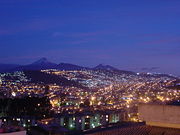
The northern part of Quito is the site of the main business district and a substantial number of buildings. It is also where the international airport (UIO) and major recreational areas are located.
Plaza de toros de Quito- is a bull ring in Quito, Ecuador. It is currently used for bull fighting. The stadium holds 15,000 people and was built in 1960.
Museo del Banco Central
This museum is a showcase of Ecuadorian art, history and culture. The ground floor features an extensive collection of pre-colonial (including pre-Incaic) potteries, sculptures, gold, lithics, and other artifacts such as a mummified body. There also are remarkable (if somewhat distorted) models to show the way various parts of Ecuador may have looked at the time, from the Pambamarca fort to the Cochasquí tumuli complex. The highlight of this collection is a golden sun mask of the La Tolita culture. The second floor is dedicated to Colonial art, and paintings and sculptures with religious themes are exhibited. The third floor is devoted to contemporary Ecuadorian art.
Parks
- Parque Metropolitano Guanguiltagua , with its 1,376 acres (5.57 km²) is the largest urban park in South America. (As reference, New York's huge Central Park is 843 acres (3.4 km²).) The park is located in the north of Quito, on the hillside, behind the Atahualpa Olympic (Soccer) Stadium. The park is suited for mountain biking, walking, or running. Most of it is eucalyptus forest with trails, but there also are numerous sculptures on display. The park has four sites that can be used for picnics or barbecues, and the eastern section has a view of Cotopaxi, Antisana and the Guayllabamba river basin.
- La Carolina is a 165.5 acre (670,000 m²) park in the Benalcázar parish in the middle of Quito's business and shopping district, bordered by three major streets: Avenida Amazonas, Avenida Shyris, and Avenida Naciones Unidas. Quiteños gather at La Carolina mostly on weekends to play soccer, basketball, ecua-volley (an Ecuadorian variation of volleyball with less emphasis on spiking, which allows more of a throw and allows using the feet, much like soccer). Other activities include aerobics, kite flying, running, snacking, and people watching. The southern part of the park has a small pond where paddle boats can be rented, and a skatepark for bicyclists and skateboarders. Artists are known to perform on weekends at the park. In the western part of the park visitors will find the Quito Exhibition Centre with different exhibits every month, the Quito botanical gardens, and a Vivarium.
- El Ejido is situated between the old part of the city and the modern section. This park is known for handicrafts available for sale every Saturday and Sunday, with all pricing subject to negotiation (i.e. haggling). Local painters sell copies of paintings by Oswaldo Guayasamín , Eduardo Kingman or Gonzalo Endara Crow. Otavaleños sell traditional sweaters, ponchos, carpets and jewelry.
- La Alameda park has the oldest astronomical observatory in South America as well as a monument of Simón Bolívar and a small lake where boats can be rented.
Old Town
The "centro histórico", historical centre, as it is called, was appointed , along with the historic centre of Kraków (Cracovia) , Poland, as the first UNESCO World Heritage Cultural Site in 1978. Despite the 1917 earthquake, the city has the best-preserved, least altered historic centre in Latin America. The monasteries of San Francisco and Santo Domingo, and the Church and Jesuit College of La Compañía, with their rich interiors, are pure examples of the 'Baroque school of Quito', which is a fusion of Spanish, Italian, Moorish, Flemish and indigenous art. It has many appealing plazas (the Independence Plaza being the most important) and manierist and baroque churches, including: the Metropolitan Cathedral (official name: Catedral Primada de la Virgen Asunta al Cielo), the convent and church of St. Francis, which is the largest building of the Colonial era built by the Spaniards in South America; the church of El Sagrario; convent and church of Santo Domingo; and the church of the Society of Jesus, or "La Compañía," which was built after the model of the Church of the Gesu in Rome. The Sucre Theatre, where concerts by the National Symphony Orchestra of Ecuador are held, is in the vicinity. There also are several museums, many dedicated to Colonial art and history. The most renowned are the City Museum ("Museo de la Ciudad") , the Metropolitan Cultural Centre and the museum of the Convent of St. Francis. Markets are scattered throughout the area.
At the north-eastern edge of Old Town lies the more recent Basílica del Voto Nacional, consecrated in 1988. For the able-bodied non- acrophobic tourist, the Basílica offers a climb up its high towers leading to breathtaking views from the top.
El Panecillo
El Panecillo is a hill located in the middle west of the city with an altitude of about 9,895 feet (3,016 m) above sea level. The monument to Virgin Mary located on top of El Panecillo is visible from most of the city of Quito. This monument is based on a sculpture made by Bernardo de Legarda in the Spanish Colony time known as 'La Virgen de Quito'.
In 1976, the Spanish artist Agustín de la Herrán Matorras was commissioned by the religious order of the Oblates to build a 134½ foot (41 m)-tall aluminium monument of a madonna, which was assembled on a high pedestal on the top of Panecillo. Made of approximately 7,000 pieces of aluminium, the monument was inaugurated on March 28, 1976, by the 11th archbishop of Quito, Pablo Cardinal Muñoz Vega.
The figure stands on top of a globe, stepping on a snake (classic madonna iconography). What is not so traditional, however, is her wings. The monument was inspired by the famous "Virgen de Quito" (Quito's Madonna), also known as "the dancer" sculpted by Bernardo de Legarda in 1734, which now decorates the main altar at the Church of St. Francisco. This madonna represents a turning point of the Quito School of Art (one of the most renowned of the Americas) because it shows a figure with great movement (practically dancing) as a contrast with the traditional static madonnas produced during the 18th century.
Aerial tramway to Cruz Loma
Since July 2005, Quito has an aerial tramway, known as the " Telefériqo," from the city centre to the hill known as Cruz Loma on the east side of the Pichincha volcano. The ride takes visitors to an altitude of about 13,400 feet (over 4,100 m) where they find a number of restaurants, coffee shops and a variety of stores. There are also trails for hiking and areas where pictures can be taken of Quito. Due to the increased altitude and the wind on the mountain, it is considerably cooler.
Besides the aerial tramway to Cruz Loma, the Telefériqo as a whole is a visitor centre that includes an amusement park ( Vulqano Park), fine dining restaurants, Go Karts, Paint Ball, shopping malls, extensive food court, and other attractions.
Outside the city
La Mitad del Mundo (the middle of the world) is a small village administered by the prefecture of the province of Pichincha, 22 miles (35 km) north of Quito. The village features a large monument, built on the site where the equator was thought to have crossed the area in the early 1980s. There is also a museum that contains a model of Quito, a planetarium, various exhibits, several restaurants, an open arena that is occasionally used for folkloric dance performances, and a small chapel where couples can marry with one spouse standing in the northern hemisphere and the other in the southern [it has since been determined that the actual equator is some 200 meters north of the monument area].
Pululahua is a volcano a few miles northwest from La Mitad del Mundo. Its caldera (crater) is visible from a spot easily accessible by car, and is believed to be one only a few in the world with human inhabitants. It is also the site of a Geo Botanical Reserve.
Quito Zoo located near the village of Guayllabamba, about 12 miles (20 km) outside Quito, has the biggest collection of native fauna in Ecuador, including several kinds of animals that are sometimes targeted in Ecuador in the illegal fur trade.
Other nearby natural attractions include:
- Pasochoa Volcano reserve
- Cotopaxi Volcano National Park
- Illinizas Peaks Ecological reserve
- Antisana volcano reserve
- Rucu and Guagua Pichincha volcanoes
- Papallacta and Oyacachi Thermal springs
- Cayambe Volcano - Coca National Park
- Mojanda Cajas lakes
- Mindo Nambillo Cloud forest reserve
- Otavalo crafts market
Schools
According to the National Council for Higher Education of Ecuador (CONESUP ), here is a list of Schools founded before the year 2000 in the Quito and surrounding area:
| University | Foundation Date |
|---|---|
| Escuela Politecnica Javeriana de MY FAT | 29/11/1995 |
| Escuela Politecnica Nacional | 27/08/1869 |
| Universidad Politécnica Salesiana | 05/08/1994 |
| Pontificia Universidad Catolica del Ecuador | 04/11/1946 |
| Universidad Central del Ecuador | 18/03/1826 |
| Universidad de las Americas | 29/11/1995 |
| Universidad Internacional del Ecuador | 30/08/1996 |
| Universidad Particular Internacional SEK | 30/06/1993 |
| Universidad San Francisco de Quito | 25/10/1995 |
| Universidad Tecnologica America | 20/08/1997 |
| Universidad Tecnologica Equinoccial | 18/02/1986 |
| Universidad Tecnologica Israel | 16/11/1999 |
| Escuela Politecnica del Ejercito | 20/12/1977 |
Professional football teams
- Liga Deportiva Universitaria
- Club Deportivo El Nacional
- Sociedad Deportiva Aucas
- Sociedad Deportivo Quito
- Club Deportivo Universidad Católica del Ecuador
Sister cities
Quito has nine sister cities:
 Madrid, Spain
Madrid, Spain Buenos Aires, Argentina
Buenos Aires, Argentina Bogota, Colombia
Bogota, Colombia Managua, Nicaragua
Managua, Nicaragua Louisville ( Kentucky, USA)
Louisville ( Kentucky, USA) Coral Gables (Florida, USA)
Coral Gables (Florida, USA) Toronto ( Ontario, Canada)
Toronto ( Ontario, Canada) Buxton, (England, United Kingdom)
Buxton, (England, United Kingdom) Santo Domingo, (Dominican Republic)
Santo Domingo, (Dominican Republic)
